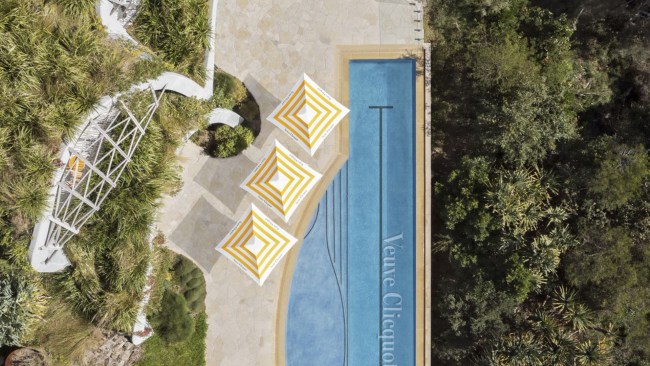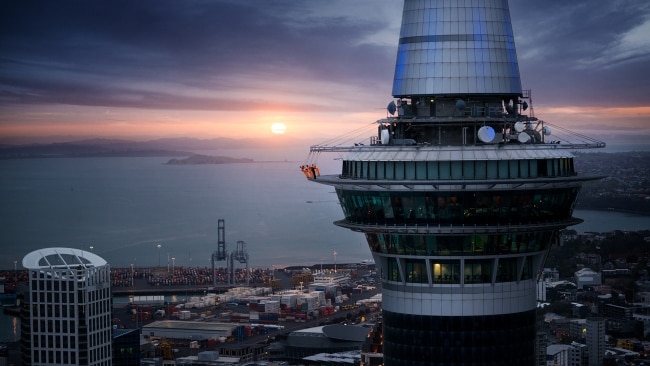On golden lake
DRIFT around Kerala's backwaters, with banana curry for lunch and blue butterflies circling.

DRIFT around Kerala's backwaters, with banana curry for lunch and blue butterflies circling.
May in Ayemenem is a hot, brooding month. The days are long and humid. The river shrinks and black crows gorge on bright mangoes in still, dust-green trees. Red bananas ripen. Jackfruits burst. Dissolute bluebottles hum vacuously in the fruity air. Then they stun themselves against clear windowpanes and die, fatly baffled in the sun. The nights are clear but suffused with sloth and sullen expectation.
-- Arundhati Roy. The God of Small Things
THE wooden boat glides under a boom gate and down a cool green canal to hotel reception, where there is a pleasure swing and staff garlanding guests with marigolds and offering sweet coconut water. Two ibises walk ahead of me to my bungalow, which comes with an ensuite cow ("meet your lawnmower, madam") and a hammock.
Welcome to Coconut Lagoon at the mouth of the Kavanar River at Kumarakom in India's southwest state of Kerala. Along a dirt path lies Ayemenem, the village where Booker prize-winning author and human rights activist Arundhati Roy grew up. Later I will visit there and brush past temple elephants lumbering in the mango-scented night.
Guests soon discover life here is on, and of, water. Channels flow through tropical gardens and beneath little arched bridges. The canal meanders into the river and then into Vembanad Lake, which is a true inland sea. It is all so organic and mulchy I expect to wake up from an earth-bound bed next morning and shake off the soil.
Coconut Lagoon is a member of the CGH Earth portfolio, a well-established Indian group with properties across Kerala and in Gokarna, on the midwest coast, and Pondicherry to the east. Most of its accommodation is in
restored heritage homes and small palaces; there's a repurposed colonial boatyard in Kochi, Kerala's gateway port, while Coconut Lagoon is perhaps the most earthed, consisting of relocated historic bungalows and so-called mansions of timber and tile on a one-time coconut plantation. The main reception building, with an open-roofed courtyard, is from the 1860s and was moved from the nearby village of Vaikom and given a majestic site on this sprawling low-rise estate.
Walking around Coconut Lagoon is like exploring a tropical arboretum, with endangered Vechur cows and gangly ibises mooching about. Happily, most of the trees have signs, so you can sort your sheltering Indian almonds (a favourite of bats) from your laburnums, bullet wood trees from wild rose apple. In a thorny clump of bamboo roost great reed warblers and greater coucals. There is a butterfly glade with a big sign that reads like an apartment building's list of residents; what fun if you could press a button to summon a zebra blue, a red pierrot or the fantastical-sounding chocolate pansy.
The resort's Ayurveda Centre, in its own pavilion with river and rice-field views, has a range of health-giving treatments, including vigorous massages. There's none of the modesty, with draperies and strategic towels, that come as standard at Asian spas. Here you are naked, basted and pummelled, perhaps popped into a medicated steam bath within an old-fashioned wooden cabinet or covered with banana leaves and left in the sun for an hour.
Buttermilk could be poured on your forehead to assist nervous tension or herbal oil massaged into the scalp to slow hair loss. None of this is for timid souls who like to keep their trousers on, but the therapies are fantastic, tailored to your ailments, from rheumatism to insomnia, after a consultation with an Ayurvedic doctor. A standard massage with medicated oil costs 1400 rupees ($32).
But despite the attractive nature of this oasis, most visitors are here for boat tours of the backwaters, a silvery universe of rivers, lakes and estuaries that runs parallel to the Malabar Coast for about 150km from Kollam in the south to Kochi in the north. Your departure point could be your hotel's water-lapped doorstep or a riverside jetty.
On a previous visit to this neck of Kerala, I took an overnight cruise but this time it is a daytime outing with a small group of fellow travellers on a large kettuvallam, or "sewn canoe", typical of the 1700-plus converted riceboats that have turned their trade to tourism. The jackwood vessels are made without nails; planks are lashed with coir rope and coated with resin made from boiled cashew nut shells. The rounded roof is of coconut thatch arranged in layers.
The low, curved profile, textured and crouched, of our good vessel Rainbow Gold reminds me of an armadillo, and our speed is indeed as unhurried as one of nature's more slow-moving creatures. It is a splendid example of the houseboat genre, with looming sideboards, ceiling fans and chandeliers, wicker lounges and satellite television.
Captain Veni and able boatman Aji soon have us weaving in and out of the parade of craft on the lake, sending cormorants and kingfishers flying in our wake. Our average pace is about 15 knots and Aji makes sure we are aware Rainbow Gold is no common old tub but a "top-range model".
We pass dug-out canoes so primitive they could have sailed out of the Old Testament and little vessels laden with hessian-wrapped bundles, hauls of glistening karimeen fish (still caught by hand in the muddy shallows) and coconuts, always coconuts, in this most palm-laden of Indian states. Fishermen with their heads clothed against the heat are collecting mussels; chaps in a two-person canoe hold the side of Rainbow Gold and hitch for a while before skimming into a side channel.
A big industrial barge chugs past and in the depths of its cargo of coconut fibre we spy orange umbrellas, then flashes of matching saris; two women are all but concealed in springy piles aboard this most unorthodox taxi.
Worryingly, the driver appears to be asleep, perhaps passed out after communion with a riverbank coconut toddy stall.
Lunch is produced by Venu, the onboard cook, and we attack with relish delicious fried karimeen that has been freshly purchased from passing fishermen, chicken curry fiery with chillies, a spicy banana curry with bitter gourd, and oodles of side dishes, including yoghurt with sliced green mango, and shredded cabbage and grated coconut with mustard seeds. It all goes splendidly with puffy pappadums and twice-cooked rice, slightly coarse and nutty.
Then it's back to relax on seats and benches, to wave at passers-by and note in detail the gaily painted buildings on shore as we push into the beds of water hyacinth that clog the side canals and upper reaches of the lake. Some of the structures, including a church painted in girlish pink, are so low to the bank their foundations are damp, like dipped hems. We get our skirts and jeans wet, too, when we transfer from the riceboat to a canoe to be paddled farther upstream on a brief excursion
under low arched palms that brush against our hair. Bright blue butterflies form haloes above our heads and yellow and black woodpeckers tap away like cartoon characters.
At the little lakeside rice-farming village of Chennamkary, ferries that look lifted from the cute Tugga-Tugga Tugboat children's book jostle at a pier. Captain Veni says there is a Catholic church on one side of the river here and a Syrian Christian church on the other. "No problem," he says, shrugging. "Hindu temple as well."
St Thomas the Apostle arrived in Kerala in AD70 and changed forever this near-satellite of India. "Christianity," wrote Roy in her lush and circuitous The God of Small Things, "arrived in a boat and seeped into Kerala like tea from a teabag."
This trip has had a reverse effect of sorts. After four visits, Kerala has done a pretty comprehensive job of seeping into my soul. It is India lite, a prosperous state with a high education level, a relaxed attitude towards religion, a palpable sense of prosperity, a tourism industry built on relaxation, on good food and fine health, of an easy and sensible engagement with nature.
Back at Coconut Lagoon, we trot along a winding dirt path to Ayemenem; there's a Hindu festival in full sway with ceremonial elephants, fire flares, drummers, tinny Bollywood music bursting from speakers in the mango trees and fluoro-lit stands selling vivid bangles and garlands of marigolds. I break my sandal strap, so must catch an autorickshaw three-wheeler back to the resort. The young driver resiles when I ask him how much for the fare. "No charge today. Happy festival," he says, smiling.
Susan Kurosawa was a guest of Singapore Airlines, Silk Air and Wildlife Safari.
Checklist
Coconut Lagoon is not accessible by road; hotel boats ply to and from Kavanattinkara jetty, 95km from Kochi. The transfer takes about 10 minutes. September to March are the coolest months, although the pre-monsoonal heat is already building at the end of that period. More: www.cghearth.com.
Wildlife Safari has a Kerala Kaper for $2995 a person, twin- share, which includes two nights at Malabar House, Fort Cochin; two nights at Windermere Estate, Munnar; and three nights at Coconut Lagoon. Daily breakfasts are covered plus private vehicle with driver, English-speaking guide, entrance fees and full-day private rice boat cruise. More: 1800 998 558; www.wildlifesafari.com.au.
Singapore Airlines has almost 100 flights a week to Singapore from five Australian capitals, with connections to 10 destinations in India, including Mumbai, Delhi, Bangalore, Kolkata, Chennai and Ahmedabad; services to Kochi, Thiruvananthapuram, Hyderabad and Coimbatore are operated by regional partner airline Silk Air. More: 131 011; www.singaporeair.com.au; www.silkair.com.



